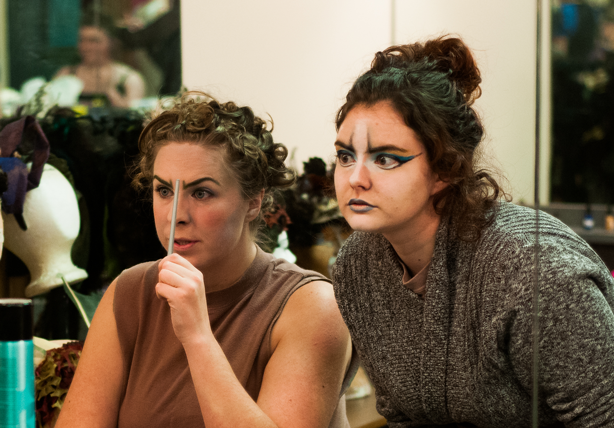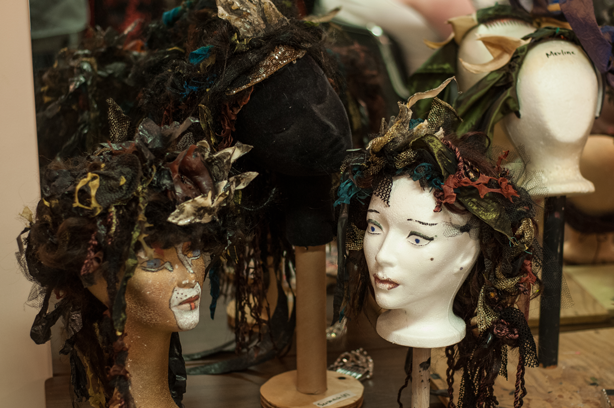By Dessa Bayrock (The Cascade) – Email
Print Edition: November 6, 2013
The show
Nearly everyone is familiar with the story of the little mermaid – a girl caught between two worlds, forced to choose between love and family, land and sea, legs and tail.
But that being said, UFV’s production of The Little Mermaid promises to twist under the gaze of the audience, flowing out from under the oft-told version and transforming into a new, dark, and ultimately local story set in BC’s appropriately cold and coastal water.
“That was a really fun, exciting thought,” director Colleen Lanki says, amid the hustle and bustle of 20 actors preparing for dress rehearsal. “Let’s not set it in the Mediterranean or the Caribbean, let’s set it here.”
The local focus mixes with the original version of the play – the Hans Christian Andersen version of the tale, rather than the cutesy happily-ever-after Disney version. Moving away from the tropical colour scheme and into the darker colours of the BC coastline is a decision that marries well with the play’s tragedy, sacrifice, and possibly even an unhappy ending.
These themes are reflected in the colours and design of the show, from costumes to set to makeup to lighting; each designer has worked to portray sides of light and dark within the play, and the result is both beautiful and grim.
The costumes
Laura Auffray is no stranger to costume construction at UFV: the fashion student’s creations have graced the stage before in last year’s Girl in the Goldfish Bowl.
Her work also stole the show during UFV’s 2012 Absolute Fashion year-end exhibition. And judging by the designs she created and constructed for The Little Mermaid, the fantastical is an area where she is quite comfortable.
“I liked the idea of designing sea monkeys and almost frog-like creatures, rather than the traditional idea of a woman in a shell bra and a pencil skirt,” she says, caught in the middle of sewing last-minute leg fins for a mermaid queen.
Costume details range from mohawks to pointy-toed shoes to pink eyebrows to leopard-print dresses, not to mention something Auffray casually refers to as “Triton’s sea cape.”
One of the most difficult costumes she dealt with was the oil-slick-like costume of the villain, which houses three people, is sewn over with pieces of trash and fishing net, and extends “backstage and beyond.”
“[It’s] this giant, evil slug of terror and doom … and it was terror and doom coming up with the idea,” Auffray says. “How do I put three people [together] without them tripping all over each other and still being able to breathe and move? So that was a nightmare.”
The darker, murkier BC waters—and a field trip to the Vancouver aquarium—supplied more than enough inspiration for the show’s costumes.
“There are a lot of really rich purples, wine-colour, bright cyans,” Auffray says, listing them off on her fingers. “We do have bright colours [in BC], but they’re not the same as what we would think of as tropical fish … really great other colours, really rich greens, purples, and blues that we play with.”
The make-up
Where Auffray handles the tails, make-up designer Alexandra Shuurman handles the scales – a more difficult detail than you might think.
The scales themselves are applied in three different colours of make-up to each mermaid before every show, painted through a layer of lace to create a distinct scaly pattern.
There can’t be any scales on the little mermaid’s face or exposed skin, because she transforms into a human halfway through the play. So how do you explain the fact that a mermaid doesn’t have any scales?
“Here’s my scale theory: when you’re a baby mermaid, your scales start at your feet,” Shuurman explains. “As you age, kind of like we get wrinkles, mermaid scales come up. Undine’s scales stop around her midriff, because she’s the youngest. Her two sisters start coming up [to shoulders, arms] and then Triton and Pearl have them closer to their faces, because they’re older.”
In other words, scales are the crows’ feet of mermaids.
“You have to kind of figure out those things to make it make sense. Because it’s not going to make sense for me to throw a whole bunch of mermaids on stage with scales everywhere,” Shuurman laughs, turning back to the next mermaid waiting patiently in line to be painted blue.
The set, the lights
“It’s sort of an ethereal, surreal looking show,” notes Astrid Beugeling, set designer and technical manager in UFV’s theatre department. “It’s not realistic at all, and it’s supposed to be suggestive.”
Beugeling was faced with a challenge in designing the set for this particular show, since the first half takes place completely underwater and the second half completely on land.
“You can’t paint the whole set blue because you’re underwater, because how do you justify that in the second half?” Beugeling says with a wry grin. “So you have to find elements that are a little bit of both.”
The result is “a very clean, simple look” that uses a sand-coloured floor and relies on fabric to build the mermaids’ sea palace in the audience’s mind. The stage rises in simple steps toward the back to add another level to the stage. The set is augmented by stark white blocks that act as any needed furniture – stacked together to make tables or benches, set upright to create chairs or railings, and tipped to the side to make low stools.
“The audience just goes with you no matter where you end up being,” she concludes.
The use of a projector is another way that the show sets the audience in the location. While UFV’s projector is too dim to be fully effective under full stage lights, borrowing a stronger projector from the Chilliwack School of Performing Arts allowed lighting designer and recent UFV graduate Gabriel Kirkley to use the projections to their full potential.
The back of the set is left bare to the white scrim—basically a large white sheet—which allows the projections to take a large part in the set.
Kirkley’s favourite scene, however, combines both projection and standard stage lighting to make the scene come together.
“There’s one scene when Undine rescues the prince in the middle of the storm and pulls him up onto the shore,” he explains, “and I’ve got this beautiful sunset projection and this nice lighting coming down on the platform … ah, it makes me so happy.”
The curtain rises
Production design is a part of theatre that can often be overlooked, but it supports everything the actors accomplish on stage.
“That’s what design is. It’s coming back to the character, doing everything you can to support the character onstage,” Shuurman concludes. “I think that extends to all elements of design.”
The magic of good design is one that still has a hold over director Colleen Lanki, even after years of study and practice in theatre.
“I like the transformational quality of some of the stuff – being able to use one object as a whole bunch of things. That’s something I really enjoy,” she says. “It’s kind of magic for me to watch something be a boat one minute and water the next.”
Ticket information
The Little Mermaid runs from November 6 to 24, with curtain at 7:30 for evening shows and 2:30 for matinees.
For the first time ever, tickets are available to be purchased online and printed at home, ranging between $11 and $23.
UFV Theatre is also introducing “rush sale” tickets for students for the first time with The Little Mermaid. Any tickets not sold an hour before showtime will be sold at an $8 price point, cash only, to anyone with a student card and a desire to see the show.
“Rush tickets are more suited to the type of audience member who wants to decide to see a show at the last minute and doesn’t feel particular about seating,” says Melanie Wickes, UFV Theatre’s publicity coordinator.
If the rush sale tickets are successfully with this show, it might become a staple at the UFV box office.
“We are going to try out student rush tickets for The Little Mermaid and see how it goes,” Wickes concludes. “I’m hoping it’s a regular thing.”



